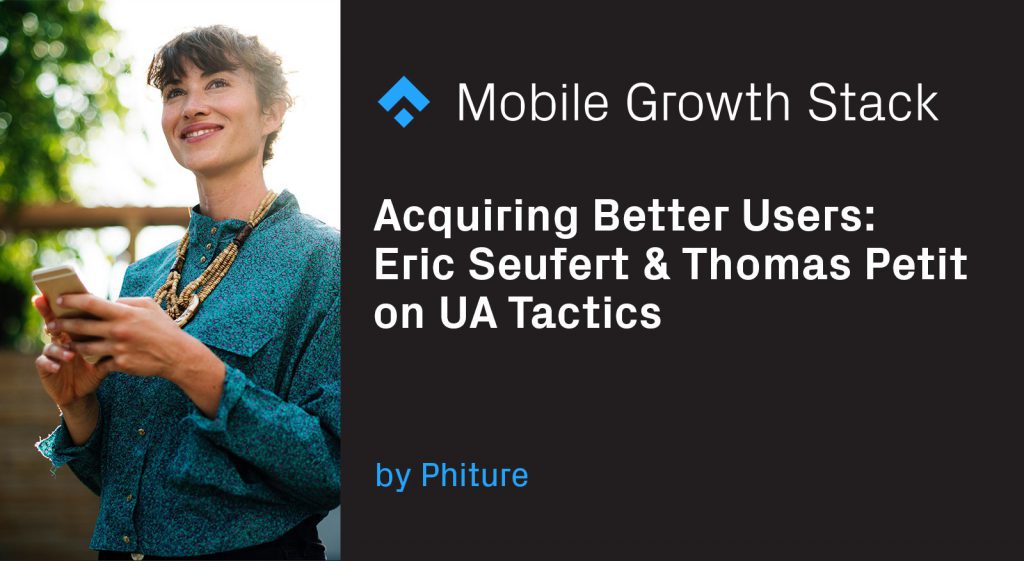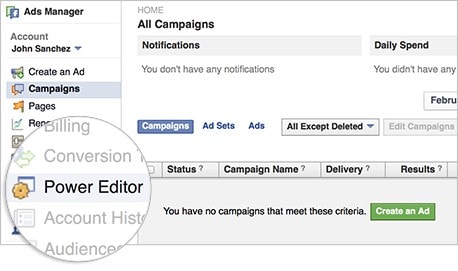
Paid User Acquisition (UA) is the most important scalable growth channel for apps and the one that app developers have most control over— leveraging audiences, ad networks, budgets, and ad creatives. Yet it can be daunting to spend thousands on acquiring new users without knowing a certain outcome.
We’ve asked two of the industry’s top UA experts, Eric Seufert (Heracles Consulting, formerly VP User Acquisition at Rovio) and Thomas Petit (Head of Growth at 8fit) to share their knowledge on what to look out for when acquiring users.
What would you recommend to app developers just starting out with UA? Which tools and analytics setup would you consider a minimum requirement?
Thomas Petit: Never start spending a cent unless you have an attribution partner in place for starters, whichever it’d be. You’ll want to be tracking your main events with it to improve UA, but also be sure to track a very detailed level of internal events for Product iteration.
Be sure to define your success KPIs beforehand, in my opinion, Return on Advertising Spend (ROAS) and/or day7 / day30 retention would be the 2 best metrics for most developers.
I would recommend to newcomers to focus on direct sources first. There is a reason a majority of ad spend lands in Facebook and Google’s hands, and while they’re not the solution to all needs and scale, they’re often the best place to get started, gather insights and define target KPIs. The scaling opportunity they offer across their ecosystem is massive (think Instagram, YouTube etc also) before you’ll feel the need to expand.
Eric Seufert: I tell most people that are just starting out to only use Facebook. Facebook provides an end-to-end UA toolkit: a (reasonably) easy to use media buying interface (PowerEditor), attribution, app event optimization, and basic analytics. Unless there’s a pressing need for a company to be diversifying their spend across many networks right out of the gate, scaling an app up on Facebook over the course of a few weeks/months and then onboarding new networks gradually is probably a better approach to take than trying to roll out a massive portfolio of traffic sources all at once.

Facebook Power Editor
There are two other benefits to taking this approach besides convenience. The first is that this can be done without a dedicated in-house UA person, so it usually means an executive is handling Facebook buying. And since UA is such an integral part of running an app-based business, it’s really great when someone on the executive team has the kind of fundamental, visceral understanding of UA that only optimizing campaigns and building out the early infrastructure can provide.
And the second benefit is that it forces a lot of discipline around the measurement, reporting, and analysis processes that underpin a successful, functional UA team. The Facebook ecosystem is very transparent: there’s nowhere to hide. When UA teams try to scale up from nothing really quickly, they often throw together a system of third-party tools and in-house data infrastructure that takes months to get operational via integrations. When this happens, it’s easy for the UA team to take a lot of shortcuts in terms of analysis because “they can’t get the data”, e.g. attribution is broken or in-app events aren’t being stored properly.
With Facebook, that’s impossible (or at least very hard) to do: everything comes straight from the SDK. And so starting with Facebook instills the reporting and analysis discipline that teams should be developing at that inchoate stage of the team’s formation.
Would you recommend relying on fewer major sources of traffic vs many different networks? What does a healthy traffic mix look like from your perspective?

Eric Seufert
Eric Seufert: There’s a moment for each of those approaches in an app’s lifecycle, depending on the level of saturation and spend.
One inefficient thing I see a lot of teams do is diversify their sources really early before they’ve nailed down a coherent, viable positioning strategy (tone of the art, etc.) and figured out their reporting, so you’ll have people say things like “Network X provides really great traffic but doesn’t support a lot of volume.”
Volume is a determinant of whether traffic is “great” or not; if you’re getting 20 or 50 or whatever installs a day, a network isn’t “great”, no matter what the traffic looks like. In situations like this, the team’s time would be better spent on more conceptual things (eg. helping the development team identify chokepoints in the app, or finding better events to optimize against) rather than trying to tune campaigns that are delivering a negligible number of daily installs. You can’t build a business that way.
Thomas Petit: The healthy mix depends a lot on the stage and scale of operations. At first, definitely nail it down to a few or even just one in a very early stage. You’ll fast forward learnings, avoid de-duplication issues and focus at a deeper level of insights.
As the business grows, it makes sense to diversify sources to limit dependency, tap into different inventories, limit exhaustion and expand reach.
What are some of the pitfalls to avoid when acquiring users for the first time?

Thomas Petit
Thomas Petit: The biggest mistake is probably to rely on early funnel metrics, like CPI or CPL, which are poor indicators of the real business value. It took a while but we’re finally getting there as developers move to meaningful CPAs. If you have some direct revenue stream in-app (IAP, subscription, e-commerce), ROAS is the ultimate goal.
You may find early proximity metrics that correlate with your real goals, which will help, but very rarely those would be installs or signups.
I would also try to narrow down the scope at first, in terms of sources/networks, geo & OS before expanding.
When working with ad networks, what do you look out for? What are the possible red flags?
Eric Seufert: Reporting API, standard IO terms, easy integration with my other 3rd party partners. The ad network profile is pretty normalized now; there aren’t a lot of rogue actors doing weird things.
Thomas Petit: To be frank, even at scale I rarely work with ad networks to prioritize first-party sources (social networks, direct deals).
I’m a strong advocate of independent business and a startup fan, but I would avoid a newly born ad network to favor major traffic providers with proven record and decent fraud reputation.
If and when evaluating new partners, I’d look into what kind of targeting/segmentation they offer, how solid is their API, can they truly optimize based on post-install events, what level of transparency do they offer.
Ad networks are intermediaries, but be sure to verify where the traffic is actually coming from and avoid any rebrokered traffic.
Once running, I look at deep funnel metrics. The higher the KPIs, the easiest fraud will fake it: ban any CPM/clicks deal, and track deep post-install metrics, revenue being the toughest to crack for fraudsters.
No matter where you place your bets, if it looks too good to be true there’s usually something fishy going on.
Is there generally a difference in how UA is approached for subscription apps (as opposed to freemium apps)?
Thomas Petit: While sources and targeting tactics would likely be quite similar, the approach to data modelling is definitely different in a subscription model.
The way one factors lifetime value differs greatly, and a lot of your success will be based on renewals, not first subscriptions.
In our case, we track 2 KPIs for subscriptions: d0-ROAS and LTV-ROAS.
Eric Seufert: Sort of. LTV is actually easier to calculate for subscription services, but few subscription apps have been operating for long enough to really understand their churn rate and customer lifetime. So with subscription apps you’re generally optimizing for that first payment event like social casino apps do with deposits, but you’re also giving more weight to non-paying installs than casino apps do because of the magnified importance of virality for subscription-based consumer services.
How do you find the best sources to buy users? How sophisticated does the targeting need to be to achieve robust results?
Eric Seufert: The best way is to identify your core user demographic before you build the app so that your finished product is something that people want to download. When you have something that people want to buy — when your ads prompt clicks because of an inherent level of consumer interest — then every ad channel can be a great ad channel.
Thomas Petit: Test, measure, rinse & repeat. Experimentation is the only way to proceed, there is no silver bullet that will provide outstanding performance for all apps. Every product is specific and will resonate to a different audience.
To my surprise, I’ve seen success with unlikely targeting options, sometimes you want to try something different.
How important are ad copy and images to attract the right users? What is your process on ad asset development and testing?
Eric Seufert: Critically important but these things are easy to test. I usually do a few rounds before launch to try to nail the positioning and then iterate weekly or bi-weekly after that. One thing I like to do is always run a wildcard, weird ad variant: something totally different from the historical norm. Those ads usually perform much better than the more incremental variants just because big changes always shock performance in mean-reverting processes like display advertising, but they can usually provide some good signal around subtle, different directions to take the app’s messaging in.
Thomas Petit: Creatives are critical for top-funnel metrics and will often define the price you’re paying for a given inventory. While targeting is often the key to drive higher quality installs (output), creative iteration is the way to lower prices (input): a higher CTR will give a bigger eCPM to the publisher for a lower CPI for the advertiser. Don’t abuse it with click-bait or quality will eventually suffer
As for targeting: test, measure & iterate again and again. Successful creative can sometimes be counter-intuitive. It takes a few iterations on the same assets before we nail it to the right combinations of elements.
If you can afford the higher cost of production, video creatives are a must, so image and copy won’t be the only lever.
In our case, we’re lucky to have an in-house media production team that creates unique assets that match our brand positioning and can adapt fast to the results we see.
The ecosystem of Ad Networks, DSPs, Mediation Partners, etc. is often confusing for those new to the topic. Are there any online resources you would recommend that demystify some of the jargon?
Eric Seufert: Mobile Dev Memo 🙂
Thomas Petit: Mobile Dev Memo, grow.co, AppAnnie, Adespresso, Liftoff, and Mobile Growth Stack.
If you have other questions or input on UA, let us know in the comments.
Table of Contents












